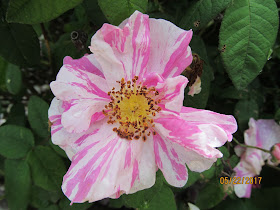Aloha friends!
How have you been? Here's the second part about our trip to Virginia. Enjoy!
The morning of May 22nd (Monday) found us meeting the group at Hopkins Green in Lexington, Virginia. Everyone received earphones so we could all listen to Mr. Potter speak as he led the tour around the city. The first place he led us to was the Lexington Presbyterian Church where he talked about Thomas Jackson's affiliation with that church. In fact, it was at that church that he started a Sunday school for black slaves.

The next stop was Thomas "Stonewall" Jackson's house where a tour was given. I wasn't able to get very many pictures of the inside of the house, but here's one of the outside that I found online.
This typical Federal-style town house, with a later stone addition, was the home of Thomas Jonathan Jackson and his wife, Mary Anna. They lived here with five of their six slaves before the Civil War. After her husband's death in 1863, Mrs. Jackson kept the house as a rental property until 1906. She sold it to the United Daughters of the Confederation to use as a community hospital. The house served as Stonewall Jackson Memorial Hospital for nearly fifty years and underwent many changes before becoming a museum.
The Jackson house was restored in 1979 to look as it did when the Jacksons lived here, and underwent additional renovations in 2004. 

There was a sizeable garden in the back of the house with strawberries plants that were ripe with berries, as well as many beautiful flowering plants.
After finishing the tour at the Jackson house, the group walked a few blocks away to the cemetery where Thomas Jackson is buried. Notice the lemons in front of the monument-Jackson really liked them.
Here's a little history: Thomas Jackson is best known for his leadership of Confederate troops during the American Civil War, and especially for his celebrated Valley Campaign of 1862. Thomas Jackson was a country boy from (West) Virginia who became a graduate of the United States Military Academy and a hero of the Mexican War. In 1851 Major Jackson came to Lexington to teach Natural Philosophy at the Virginia Military Institute. Jackson left Lexington in April 1861, at the outbreak of war, and never returned alive. General Jackson's leadership earned him the admiration of his troops and lasting fame. He was fatally wounded on May 2, 1863, after he collaborated with General Robert E. Lee to achieve victory at the battle of Chancellorsville. Jackson's body was brought back to Lexington for burial.
Moving on.....
A couple miles away was Washington and Lee University.
We sat inside Lee chapel, which was constructed at the request of Lee while he was president of Washington
College (now Washington and Lee University) after the Civil War, and listened as the curator talked a little about the building and its history. The following pictures are of Robert Lee and George Washington, and the marble sculpture of Robert Lee.
This marble sculpture of Robert E. Lee taking a nap on the battlefield was created by Edward Valentine.
There were many plaques on the wall like the one above and I asked about them. The historian of the museum told me the history of this particular plaque. Kiffin Yates Rockwell was the first American pilot to shoot down a German plane in World War I.
This room located in the church was Lee's study.
The Virginia Military Institute was just down the street from Washington and Lee University.
The four cannons in front of the Institute were named Matthew, Mark, Luke, and John by Col. William Nelson Pendleton and the seminary students. They were donated to VMI by President Zachary Taylor in 1850.
After leaving VMI, we attended a small ice cream social hosted by one of the families who had been on the previous tour.
Hopefully I'll be able to share part 3 very soon. I had originally planned to add the historical information we learned on the trip in these posts, but sadly, the notebook I took notes in was lost.
I hope you have a wonderful day!





















What a yummy looking strawberry. I wish I could eat it, don't ya'll. I love strawberries and if you have a strawberry patch I will come and eat them all up.
ReplyDeleteOh Deborah, :) I wish I could have a strawberry patch. They would probably all die in this heat. Perhaps in the winter we'll have a strawberry patch. :)
DeleteNope, we won't be able to have one. The animals would destroy it and eat all the strawberries. Especially the animals that root their noses into the ground. I will eat all of your followers strawberries though. 🍓🍓🍓🍓🍓🍓🐕🐓🐄🐖🐴🐓🐄Deborah
ReplyDeleteWell I have a garden now and the animals don't mess with it because of the fence. I am putting a strawberry patch on the list of things to plant in the fall/winter. :)
DeleteOh yea, I believe it when I see it. The chickens go in your garden right now and the pigs will knock the fence down lol. 😀😄😬😜😛
DeleteDespite being on the Confederate side, Lee and Jackson were not only remarkable generals, but also men of remarkable character. That's so neat you were able to tour all those sites. Also love the names of those four cannons! XD
ReplyDelete